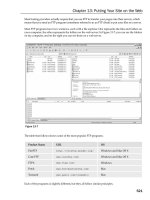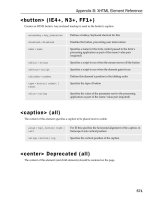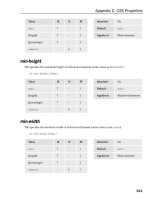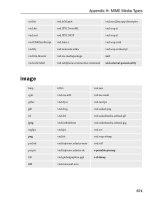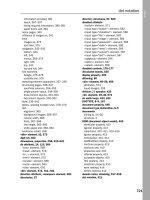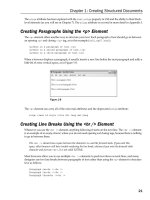Tài liệu Financial Modeling with Crystal Ball and Excel doc
Bạn đang xem bản rút gọn của tài liệu. Xem và tải ngay bản đầy đủ của tài liệu tại đây (5.13 MB, 290 trang )
Financial Modeling
with Crystal
Ball and Excel
JOHN CHARNES
John Wiley & Sons, Inc.
Financial Modeling
with Crystal
Ball and Excel
Founded in 1807, John Wiley & Sons is the oldest independent publishing company
in the United States. With offices in North America, Europe, Australia and Asia,
Wiley is globally committed to developing and marketing print and electronic
products and services for our customers’ professional and personal knowledge and
understanding.
The Wiley Finance series contains books written specifically for finance and
investment professionals as well as sophisticated individual investors and their
financial advisors. Book topics range from portfolio management to e-commerce,
risk management, financial engineering, valuation and financial instrument analysis,
as well as much more.
For a list of available titles, please visit our Web site at
www.WileyFinance.com.
Financial Modeling
with Crystal
Ball and Excel
JOHN CHARNES
John Wiley & Sons, Inc.
Copyright
c
2007 by John Charnes. All rights reserved.
Published by John Wiley & Sons, Inc., Hoboken, New Jersey.
Published simultaneously in Canada.
No part of this publication may be reproduced, stored in a retrieval system, or transmitted in any form
or by any means, electronic, mechanical, photocopying, recording, scanning, or otherwise, except as
permitted under Section 107 or 108 of the 1976 United States Copyright Act, without either the prior
written permission of the Publisher, or authorization through payment of the appropriate per-copy fee to
the Copyright Clearance Center, Inc., 222 Rosewood Drive, Danvers, MA 01923, (978) 750-8400, fax
(978) 750-4470, or on the Web at www.copyright.com. Requests to the Publisher for permission should
be addressed to the Permissions Department, John Wiley & Sons, Inc., 111 River Street, Hoboken, NJ
07030, (201) 748-6011, fax (201) 748-6008, or online at />Limit of Liability/Disclaimer of Warranty: While the publisher and author have used their best efforts in
preparing this book, they make no representations or warranties with respect to the accuracy or
completeness of the contents of this book and specifically disclaim any implied warranties of
merchantability or fitness for a particular purpose. No warranty may be created or extended by sales
representatives or written sales materials. The advice and strategies contained herein may not be suitable
for your situation. You should consult with a professional where appropriate. Neither the publisher nor
author shall be liable for any loss of profit or any other commercial damages, including but not limited
to special, incidental, consequential, or other damages.
For general information on our other products and services or for technical support, please contact our
Customer Care Department within the United States at (800) 762-2974, outside the United States at
(317) 572-3993 or fax (317) 572-4002.
Wiley also publishes its books in a variety of electronic formats. Some content that appears in print may
not be available in electronic books. For more information about Wiley products, visit our Web site at
www.wiley.com.
Library of Congress Cataloging-in-Publication Data:
Charnes, John Martin.
Financial modeling with crystal ball and Excel / John M. Charnes.
p. cm.—(Wiley finance series)
‘‘Published simultaneously in Canada.’’
Includes bibliographical references.
ISBN 13: 978-0-471-77972-8 (paper/cd-rom)
ISBN 10: 0-471-77972-5 (paper/cd-rom)
1. Finance–Mathematical models. 2. Investments–Mathematical models. 3.
Crystal ball (Computer file) 4. Microsoft Excel (computer file) I. Title.
HG106.C485 2007
332.0285
554—dc22
2006033467
Printed in the United States of America.
10987654321
In Memory of Gerald Daniel Charnes, 1925–2005
Contents
Preface xi
Acknowledgments xv
About the Author xvii
CHAPTER 1
Introduction 1
Financial Modeling 2
Risk Analysis 2
Monte Carlo Simulation 4
Risk Management 8
Benefits and Limitations of Using Crystal Ball 8
CHAPTER 2
Analyzing Crystal Ball Forecasts 11
Simulating A 50–50 Portfolio 11
Varying the Allocations 21
Presenting the Results 27
CHAPTER 3
Building a Crystal Ball Model 28
Simulation Modeling Process 28
Defining Crystal Ball Assumptions 29
Running Crystal Ball 32
Sources of Error 33
Controlling Model Error 35
CHAPTER 4
Selecting Crystal Ball Assumptions 36
Crystal Ball’s Basic Distributions 36
Using Historical Data to Choose Distributions 54
Specifying Correlations 63
vii
viii CONTENTS
CHAPTER 5
Using Decision Variables 71
Defining Decision Variables 71
Decision Table with One Decision Variable 73
Decision Table with Two Decision Variables 79
Using OptQuest 89
CHAPTER 6
Selecting Run Preferences 95
Trials 95
Sampling 98
Speed 101
Options 103
Statistics 104
CHAPTER 7
Net Present Value and Internal Rate of Return 105
Deterministic NPV and IRR 105
Simulating NPV and IRR 107
Capital Budgeting 111
Customer Net Present Value 121
CHAPTER 8
Modeling Financial Statements 125
Deterministic Model 125
Tornado Chart and Sensitivity Analysis 126
Crystal Ball Sensitivity Chart 129
Conclusion 129
CHAPTER 9
Portfolio Models 132
Single-Period Crystal Ball Model 132
Single-Period Analytical Solution 134
Multiperiod Crystal Ball Model 135
CHAPTER 10
Value at Risk 140
VaR 140
Shortcomings of VaR 142
CVaR 142
Contents
ix
CHAPTER 11
Simulating Financial Time Series 147
White Noise 147
Random Walk 149
Autocorrelation 150
Additive Random Walk with Drift 154
Multiplicative Random Walk Model 157
Geometric Brownian Motion Model 160
Mean-Reverting Model 164
CHAPTER 12
Financial Options 170
Types of Options 170
Risk-Neutral Pricing and the Black-Scholes Model 171
Portfolio Insurance 174
American Option Pricing 177
Exotic Option Pricing 179
Bull Spread 183
Principal-Protected Instrument 184
CHAPTER 13
Real Options 187
Financial Options and Real Options 187
Applications of ROA 188
Black-Scholes Real Options Insights 191
ROV Tool 193
Summary 200
Appendix A Crystal Ball’s Probability Distributions 202
Appendix B Generating Assumption Values 235
Appendix C Variance Reduction Techniques 243
Appendix D About the Download 249
Glossary 251
References 255
Index 263
Preface
I
wrote this book to help financial analysts and other interested parties learn how
to build and interpret the results of Crystal Ball models for decision support.
There are several books that exist to inform readers about Monte Carlo simulation
in general. Many of these general books are listed in the References section of
this book. This book focuses on using Crystal Ball in three main areas of finance:
corporate finance, investments, and derivatives.
In 1982, University of Minnesota–Duluth Business School professor Henry
Person introduced me to IFPS, computer software designed for financial planning,
that we ran on VAX mainframe computers for an MBA class in quantitative
methods. IFPS used a tabular layout for financial data similar to Excel’s, although it
was more abstract than Excel’s because one had to print the data to see the layout
in IFPS instead of working with Excel’s tabular display of the data on the screen.
Gray (1996) describes what is evidently the latest, and perhaps final, version of this
financial planning software. It is significant to me because IFPS included a Monte
Carlo command that gave me my first glimpse of using a computer as a tool for
financial risk analysis.
I was hooked. The next term, I took Henry’s class in discrete-event simulation
based on Tom Schriber’s (1974) red GPSS textbook. I found the notion of system
simulation fascinating. It made experimentation possible in a computer lab on
models of real-world situations, just as the physical scale models of dams in the
University of Minnesota–Twin Cities hydraulic laboratory made experimentation
possible for the civil engineering professors during my days as an undergraduate
student there. I saw many places where systems simulation could have been applied
to the construction industry when I worked as a field engineer, but was unaware at
the time of what simulation could accomplish.
More graduate school beckoned. After a year of teaching finance at the University
of Washington in Seattle, I returned to the Twin Cities to eventually earn my
doctorate in what became the Carlson School of Management. There I met David
Kelton in 1986. His coauthored textbook, now in print as Law and Kelton (2000),
got me started on my dissertation research that was done largely at the Minnesota
Supercomputer Institute, where I ran FORTRAN programs on Cray supercomputers
and graphed the resulting output on Sun workstations. It is amazing to me that
anyone can do the same tasks today faster and more easily by using Crystal Ball on
a personal computer. I wish that I had had today’s version of the personal computer
and Crystal Ball available to me when I worked as an economic analyst at a Fortune
50 banking conglomerate in 1985.
xi
xii PREFACE
As assistant professor in the management sciences department at the University
of Miami in Coral Gables, Florida, I taught simulation to systems analysis and
industrial engineering students in their undergraduate and graduate programs.
When I moved to the University of Kansas in 1994, I had hopes of offering a similar
course of study, but learned quickly that the business students here then were more
interested in financial risk analysis than systems simulation. In 1996, I offered my
first course in risk analysis at our suburban Kansas City campus to 30 MBA students,
who loved the material but not the software we used—which was neither IFPS nor
Crystal Ball.
I heard many complaints that term about the ’’clunky software that crashed all
the time,’’ but one student posed an alternative. She asked if I had heard of Crystal
Ball, which was then in use by a couple of her associates at Sprint, the Kansas
City–based telecommunications company. I checked it out, and the more I read in
the Crystal Ball documentation, the more convinced I became that the authors were
influenced by the same Law and Kelton text that I had studied in graduate school.
At the 1997 Winter Simulation Conference, I met Eric Wainwright, chief
technical officer at Decisioneering, Inc. (DI), and one of the two creators of Crystal
Ball, who confirmed my suspicions about our shared background. Thus began
my friendship with DI that led to creation of Risk Analysis Using Crystal Ball,
the multimedia training CD-ROM offered on the DI Web site. That effort, in
collaboration with Larry Goldman, Lucie Trepanier, and Dave Fredericks, was a
wholly enjoyable experience that gave me reason to believe—correctly—that the
effort to produce this book would also be enjoyable.
About the same time I met Eric, I had the good fortune to work with David
Kellogg at Sprint. His interest in Crystal Ball and invitation to present a series of
lectures on its use as a decision support tool led to my development of training
classes that were part of the Sprint University of Excellence offerings for several
years. I am grateful to David and all the participants in those classes over the
years for their helping me to hone the presentation of the ideas contained in this
book. I am also grateful to Sprint and Nortel Networks for the financial support
that led to development of the real options valuation tool described in Chapter 13.
Other consulting clients will go unnamed here, but they also have influenced the
presentation.
Microsoft Excel has become the lingua franca of business. Business associates in
different industries and even some in different divisions of the same company often
find it difficult to communicate with each other. However, virtually everyone who
does business planning uses Excel in some capacity, if not exclusively. Though not
always able to communicate in the same language, businesspeople around the globe
are able to share their Excel spreadsheets. As with everything in our society, Excel
has its critics. Yet the overwhelming number of users of this program make it foolish
to deliberately shun its use.
My main criticism of Excel is obviated by use of the Crystal Ball application.
Excel is extremely versatile in its ability to allow one to build deterministic models in
many different business, engineering and scientific domains. Without Crystal Ball, it
Preface
xiii
is cumbersome to use Excel for stochastic modeling, but Crystal Ball’s graphical input
and output features make it easy for analysts to build stochastic models in Excel.
In the 1970s, Jerry Wagner and the other founders of IFPS had a dream
of creating software that would dominate the market for a computerized, plain-
language tool for financial planning by executives. In the meantime, Microsoft Excel
came to dominate the market for financial planning software. The combination of
Excel, Crystal Ball, and OptQuest provides a powerful way for you to enhance your
deterministic models by adding stochastic assumptions and finding optimal solutions
to complex real-world problems. Building such models will give you greater insight
into the problems you face, and may cause you to view your business in a new light.
ORGANIZATION OF THIS BOOK
This book is intended for analysts who wish to construct stochastic financial models,
and anyone else interested in learning how to use Crystal Ball. Instructors with
a practical bent may also find it useful as a supplement for courses in finance,
management science, or industrial engineering.
The first six chapters of this book cover the features of Crystal Ball and
OptQuest. Several examples are used to illustrate how these programs can be used
to enhance deterministic Excel models for stochastic financial analysis and planning.
The remaining seven chapters provide more detailed examples of how Crystal Ball
and OptQuest can be used in financial risk analysis of investments in securities,
derivatives, and real options. The technical appendices provide details about the
methods used by Crystal Ball in its algorithms, and a description of some methods of
variance reduction that can be employed to increase the precision of your simulation
estimates. All of the models described in the book are available on the accompanying
CD-ROM, as is a link to a Web site from which a trial version of Crystal Ball may
be downloaded. The contents of each chapter and appendix are listed below:
Chapter 1 provides an overview of financial modeling and risk analysis through
Monte Carlo simulation. It also contains a discussion of risk management and the
benefits and limitations of Crystal Ball.
Chapter 2 describes how to specify and interpret Crystal Ball forecasts, the graph-
ical and numerical summaries of the output measures generated during simulation.
A retirement portfolio is used for an example.
Chapter 3 takes a helicopter view of building a Crystal Ball model. It starts
out with a simple, deterministic business planning Excel model, and then shows
you how to add stochastic assumptions to it with Crystal Ball. The chapter also
contains a discussion of possible sources of error in your models and how they can
be controlled.
Chapter 4 contains a deeper look at specifying Crystal Ball assumptions. It
describes Crystal Ball’s basic distributions and shows you how to select distributions
using historical data and/or your best expert judgment. The chapter also describes
how to use, estimate, and specify correlations between assumptions in a Crystal Ball
model.
xiv PREFACE
Chapter 5 covers the use of decision variables in detail. A decision variable is
an input whose value can be chosen by a decision maker. Decision variables enable
you to harness the power of Crystal Ball and OptQuest to find optimal solutions. A
first look at real options is included in this chapter.
Chapter 6 lists and explains the runtime options available in Crystal Ball as well
as how and when to use them.
Chapter 7 discusses the relative merits of using the concepts of net present value
and internal rate of return in deterministic and stochastic models. Examples include
capital budgeting in finance and customer lifetime value in marketing.
Chapter 8 describes how to add stochastic assumptions to pro forma financial
statements, then perform sensitivity analyses using tornado charts and Crystal Ball
sensitivity charts.
Chapter 9 presents examples of using Crystall Ball to construct single- and
multiperiod portfolio models. It also compares the Crystal Ball results for a single-
period model to the analytic solution in a special case where an analytic solution
can be found.
Chapter 10 discusses Value at Risk (VaR) and its more sophisticated cousin,
Conditional Value at Risk (CVaR), the relative merits of VaR and CVaR, and how
they are used in risk management.
Chapter 11 describes how to simulate financial time series with Crystal Ball. It
covers random walks, geometric Brownian motion, and mean-reverting models, as
well as a discussion of autocorrelation and how to detect it in empirical data.
Chapter 12 shows how to create Crystal Ball models for financial option pricing,
covering European, American, and exotic options. It includes a model to demonstrate
how to simulate returns from option strategies, using a bull spread as an example. It
also shows how to use Crystal Ball to evaluate a relatively new derivative security, a
principal-protected instrument.
Chapter 13 concludes the main body of the text with a discussion of how Crystal
Ball and OptQuest are used to value real options. It also contains a brief review of
the literature and some applications of real options analysis.
Appendix A contains short descriptions of each available Crystal Ball assump-
tion. Each description includes the assumption’s parameters, probability mass or
density function, cumulative distribution function, mean, standard deviation, and
notes about the distribution and/or its usage.
Appendix B provides a brief description of how Crystal Ball generates the
random numbers and variates during the simulation process.
Appendix C describes some variance reduction techniques, methods by which
an analyst changes a model to get more precise estimates from a fixed number of
trials during a simulation.
Appendix D provides information on downloading the Crystal Ball software
and Excel files that are used in this book.
Appendix E contains citations for the references in the text to academic and
practitioner literature relating to financial modeling and risk analysis. A glossary is
also included.
Acknowledgments
F
or their conversations and help (unwitting, by some) in writing this book
I would like to thank: Chris Anderson, Bill Beedles, George Bittlingmayer,
David Blankinship, Eric Butz, Sarah Charnes, Barry Cobb, Tom Cowherd Jr., Riza
Demirer, Amy Dougan, Bill Falloon, Dave Fredericks, Larry Goldman, Douglas
Hague, Emilie Herman, Steve Hillmer, Mark Hirschey, Joe B. Jones, David Kellogg,
Paul Koch, Mike Krieger, Chad Lander, Michael Lisk, Howard Marmorstein,
Samik Raychaudhuri, Catherine Shenoy, Prakash Shenoy, Steve Terbovich, Michael
Tognetti, Lucie Trepanier, Eric Wainwright, Bruce Wallace, and Laura Walsh.
Special thanks go to Suzanne Swain Charnes for help with editing and time taken to
indulge my interest in Crystal Ball over the years.
I enjoyed writing this book, and hope that it helps you learn how to build
stochastic models of realistic situations important to you. I will appreciate any
feedback that you send to
John Charnes
Lawrence, Kansas 2006
xv
About the Author
D
r. John Charnes is professor and Scupin Faculty Fellow in the finance, economics,
and decision sciences area at the University of Kansas School of Business,
where he has received both teaching and research awards. Professor Charnes has
taught courses in risk analysis, computer simulation, statistics, operations, quality
management, and finance in the business schools of the University of Miami (Florida),
University of Washington (Seattle), University of Minnesota (Minneapolis), and
Hamline University (St. Paul).
He has published papers on financial risk analysis, statistics, and other topics
in Financial Analysts Journal, The American Statistician, Management Science,
Decision Sciences, Computers and Operation Research, Journal of the Operational
Research Society, Journal of Business Logistics,andProceedings of the Winter
Simulation Conference. Professor Charnes has performed research, consulting, and
executive education for more than 50 corporations and other organizations in
Kansas, Missouri, Washington, Minnesota, Florida and Ontario, Canada.
Professor Charnes holds PhD (1989), MBA (1983), and Bachelor of Civil
Engineering (1980) degrees from the University of Minnesota. Before earning his
doctorate, he worked as a surveyor, draftsman, field engineer, and quality-control
engineer on numerous construction projects in Minnesota, Iowa, and Maryland. He
has served as president of the Institute for Operations Research and the Management
Sciences (INFORMS) College on Simulation, and proceedings coeditor (1996) and
program chair (2002) for the Winter Simulation Confererences.
xvii
CHAPTER
1
Introduction
L
ife is stochastic. Although proponents of determinism might state otherwise,
anyone who works in business or finance today knows quite well that future
events are highly unpredictable. We often proceed by planning for the worst outcome
while hoping for the best, but most of us are painfully aware from experience that
there are many risks and uncertainties associated with any business endeavor.
Many analysts start creating financial models of risky situations with a base
case constructed by making their best guess at the most likely value for each of the
important inputs and building a spreadsheet model to calculate the output values
that interest them. Then they account for uncertainty by thinking of how each input
in turn might deviate from the best guess and letting the spreadsheet calculate the
consequences for the outputs. Such a ‘‘what-if’’ analysis provides insight into the
sensitivity of the outputs to one-at-a-time changes in the inputs.
Another common procedure is to calculate three scenarios: best case, worst case
and most likely. This is done by inserting the best possible, worst possible, and most
likely values for each key input, then calculating the best-case outputs when each
input is at its best possible value; the worst-case outputs when each input is at its
worst possible value; and using the base case as the most likely scenario. Scenario
analysis shows the ranges of possibilities for the outputs, but gives no idea of the
likelihood of output values falling between the extremes.
What-if and scenario analysis are good ways to get started, but there are more
sophisticated techniques for analyzing and managing risk and uncertainty. This book
is designed to help you use the software programs Crystal Ball and Excel to develop
financial models for risk analysis. The spreadsheet program Excel has dramatically
changed financial analysis in the past 30 years, and Crystal Ball extends the capability
of Excel by allowing you to add stochastic assumptions to your spreadsheets. Adding
stochastic assumptions provides a clearer picture of the possibilities for each of the
outputs of interest. Reading this book and following the examples will help you use
Crystal Ball to enhance your risk analysis capabilities.
Throughout the book, I use the word stochastic as a synonym for random
or probabilistic, and as an antonym for deterministic. The majority of spreadsheet
models in use today are deterministic, but every spreadsheet user knows at some level
that there is a degree of uncertainty about each of the inputs to his or her models.
1
2 FINANCIAL MODELING WITH CRYSTAL BALL AND EXCEL
Crystal Ball enables you to use a systematic approach to account for uncertainty in
your spreadsheet models.
The first six chapters of this book demonstrate how to use Crystal Ball. The
remainder of the text provides examples of using Crystal Ball models to help solve
problems in corporate finance, investments, and financial risk management. The
appendices provide technical details about what goes on under the hood of the
Crystal Ball engine.
This chapter is an overview of financial modeling and risk analysis. Some
example applications are listed below where these tools provide insights that might
not otherwise come to light, and you get a glimpse of how straightforward it is
to assess financial risk using Crystal Ball and Excel. For a simple model that is
already built and ready to run, we will interpret the output and analyze the model’s
sensitivity to changes in its inputs. The chapter concludes with a discussion of the
benefits and limitations of risk analysis with Crystal Ball and Excel.
FINANCIAL MODELING
For the purposes of this book, financial modeling is the construction and use
of a spreadsheet depiction of a company’s or an individual’s past, present, or
future business operations. To learn more about deterministic financial modeling,
see Proctor (2004), Sengupta (2004), or Koller, Goedhart, and Wessels (2005).
For each situation where we wish to use a stochastic model, we begin with a
deterministic Excel model, then add stochastic assumptions with Crystal Ball to
generate stochastic forecasts. By analyzing the stochastic forecasts statistically, we
can make inferences about the riskiness of the business operations described by the
model. The risk analysis process became much easier and more widely available
with the introduction of Crystal Ball to the marketplace in 1987.
RISK ANALYSIS
The first recorded instances of risk analysis are the practices of the Asipu people
of the Tigris-Euphrates valley about 3200 B.C. (Covello and Mumpower 1985).
The Asipu would serve as consultants for difficult decisions such as a proposed
marriage arrangement, or the location of a suitable building site. They would list
the alternative actions under consideration and collect data on the likely outcomes
of each alternative. The priest-like Asipu would interpret signs from the gods,
then compare the alternatives systematically. Upon completion of their analysis,
they would etch a final report to the client on a clay tablet, complete with a
recommendation of the most favorable alternative (Oppenheim 1977).
According to the Oxford English Dictionary (Brown 2002), the term risk
analysis means the ‘‘systematic investigation and forecasting of risks in business
and commerce.’’ The word risk comes through French, Latin, and Italian from
Introduction
3
the Greek word rhiza, in reference to sailors navigating among cliffs. Note that
although some authorities believe that risk is derived from the Arabian word rizq,
meaning ‘‘subsistence’’ it is difficult to explain how this meaning developed into
that of ‘‘danger’’ (Klein 1967). If you bought this book to help you analyze business
problems, I will bet that you have no trouble seeing the connection between the risks
of managing a business and the perils of navigating a sailing vessel around cliffs and
barely submerged rocks that can damage the hull and sink the ship.
Imagine an ancient Greek mariner piloting a ship as it approaches a cliff or
point of rocks in uncharted waters. Another sailor is on lookout in the crow’s nest
at the top of the mast to give the earliest possible warning about how far down into
the water an outcrop from the cliff might be. A navigator nearby with sextant and
compass is keeping track of where the ship has been and the direction in which it’s
headed. His lookout warns him at the first sign of trouble ahead, but it is up to the
pilot to decide how wide to take the turn around the cliff. Cutting the corner too
close can save time but might sink the ship. Veering far from the edge is safer, but
adds costly travel time.
In navigating a strait between two cliffs, the pilot’s decision is even more difficult.
Being too far from one cliff can mean being too close to the opposing cliff. The pilot
must weigh the risks, use judgment and instinct to carefully choose a course, and
then hope for the best as vessel and crew proceed through the strait.
It is the pilot’s job to take all of the available information into account and decide
how best to sail the ship in uncharted waters. The pilot wants a clear analysis of all
the dangers and opportunities that lie ahead, in order to decide whether the potential
time savings of the ship’s chosen course outweigh the disastrous consequences of
hull damage. Even though the ship may have been through many different straits
in the past, the pilot needs a systematic investigation and forecasting of the risks
associated with the planned course through each new strait encountered during the
voyage.
If you are running a business (or are an analyst helping to run a business),
you are often in situations conceptually similar to those facing the pilot of a sailing
vessel in uncharted waters. You know where your business has been, and you are
always on the lookout for dangers and opportunities on the horizon. You operate
in an environment fraught with uncertainty. You know that future circumstances
can affect you and your business greatly, and you want to be prepared for what
might happen. In many situations, you need to weigh the favorable and unfavorable
consequences of some decision and then choose a course of action. Similar to a
ship pilot, it is your job to decide how best to navigate the straits of your business
environment. What do you do?
Fortunately, mathematicians such as Simon LaPlace and Blaise Pascal developed
the fundamental underpinnings of risk analysis in the seventeenth century by devising
the mathematical methods now used in probability theory (Ore 1960). From these
precepts came the science of statistics. ‘‘What?’’ you ask, ‘‘I studied probability and
statistics in college and hated every minute of them. I thought I was done with that
stuff. How can it help me?’’
4 FINANCIAL MODELING WITH CRYSTAL BALL AND EXCEL
In short, probability and statistics help you weigh the potential rewards and
punishments associated with the decisions you face. This book shows you how
to use Crystal Ball to add probabilistic assumptions and statistical forecasts to
spreadsheet models of a wide variety of financial problems. In the end, you still must
make decisions based on your best judgment and instincts, but judicious use of the
methods of probability and statistics that we go through in this book will help you
in several ways.
The modeling process described here enables you to investigate many different
possibilities, hone your intuition, and use state-of-the-art software tools that are
extremely beneficial for managing risk in dynamic business environments. The risk
analysis process forces you to think through the possible consequences of your
decisions. This helps you gain comfort that the course of action you select is the best
one to take based on the information available at the time you make the decision.
Risk analysis is the quantification of the consequences of uncertainty in a situation
of interest, and Crystal Ball is the tool for carrying it out.
MONTE CARLO SIMULATION
Risk analysis using Crystal Ball relies on developing a mathematical model in Excel
that represents a situation of interest. After you develop the deterministic model,
you replace point estimates with probability distribution assumptions and forecast
the distribution of the output. The forecasted output distribution is used to assess
the riskiness of the situation.
For simple models, the output distribution can be found mathematically to give
an analytic solution. For example, consider the simple cost equation
(Total Cost) = $100 + $15 ×(Quantity Produced),
where (Quantity Produced) is modelled as a normal probability distribution with
mean, µ = 50, and standard deviation, σ = 10, and we want to know the probability
that (Total Cost) is greater than $900. We don’t need Crystal Ball for this situation
because we can easily obtain an analytic solution.
A result in probability theory holds that if a random variable X follows the
normal distribution with mean, µ, and standard deviation, σ , then the random
variable Y = a +bX will also be normally distributed with mean, a +bµ,and
standard deviation, bσ . Therefore, we can easily determine that (Total Cost) is
normally distributed with mean, 100 +(15 × 50) = $850, and standard deviation,
15 ×10 = $150. Using a table of cumulative probabilities for the standard normal
distribution, or using the Excel function = 1-NORMDIST (900,850,150, TRUE),we
can find that the probability is 36.94 percent that (Total Cost) is greater than $900.
See the file Analytic.xls for these calculations, along with a Crystal Ball model that
validates the solution.


